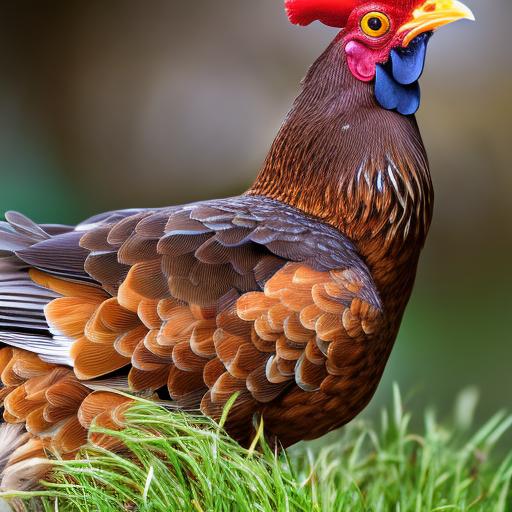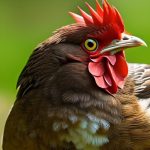Chicken head stability is an important aspect of chicken care that many owners may not be aware of. Understanding the anatomy and mechanics behind a chicken’s head stability is crucial for providing them with a comfortable and safe environment. In this article, we will explore the various factors that contribute to a chicken’s head stability, including their anatomy, muscles, vestibular system, coop design, stress levels, nutrition, and genetics. By gaining a deeper understanding of these factors, chicken owners can ensure that their feathered friends are healthy and happy.
Key Takeaways
- A chicken’s neck is made up of several small bones and muscles that work together to keep the head stable.
- The vestibular system, which helps with balance and orientation, plays a crucial role in a chicken’s head stability.
- The design of a chicken coop can impact a chicken’s head stability, with factors like space and perches playing a role.
- A comfortable and stress-free environment is important for maintaining a chicken’s head stability.
- Nutrition and genetics can also influence a chicken’s head stability, making it important to consider these factors when caring for chickens.
Anatomy of a Chicken’s Neck
To understand chicken head stability, it is important to first understand the basic anatomy of a chicken’s neck. A chicken’s neck consists of a series of vertebrae that allow for flexibility and movement. Unlike humans, chickens have a relatively short neck with only 14 vertebrae. These vertebrae are connected by joints that allow for movement in different directions.
The muscles in a chicken’s neck play a crucial role in maintaining head stability. The main muscles responsible for this are the sternocleidomastoid and splenius muscles. The sternocleidomastoid muscle runs from the base of the skull to the sternum and helps control the movement of the head. The splenius muscle runs along the side of the neck and also aids in head stability.
Muscles that Keep a Chicken’s Head Still
The sternocleidomastoid and splenius muscles work together to keep a chicken’s head still. These muscles contract and relax to maintain stability and prevent excessive movement. When these muscles are functioning properly, they provide support to the neck and keep the head in a stable position.
If these muscles become weak or injured, it can lead to instability in the chicken’s head. This can result in difficulty eating, drinking, or even moving around comfortably. It is important for chicken owners to be aware of any signs of muscle weakness or injury and seek veterinary care if necessary.
The Role of the Vestibular System in a Chicken’s Head Stability
The vestibular system is responsible for balance and spatial orientation in chickens. It consists of the inner ear and associated structures that detect changes in head position and movement. The vestibular system sends signals to the brain, which then sends signals to the muscles to adjust and maintain head stability.
In chickens, the vestibular system plays a crucial role in maintaining head stability. It allows them to navigate their environment, avoid obstacles, and maintain balance while perching or walking. Any disruption or damage to the vestibular system can lead to problems with head stability and overall coordination.
Chicken Coop Design and Its Impact on Head Stability
The design of a chicken coop can have a significant impact on a chicken’s head stability. A well-designed coop provides enough space for chickens to move around comfortably without overcrowding. This allows them to stretch their necks and move their heads freely, which helps maintain head stability.
Perches are another important aspect of coop design that can affect head stability. Chickens need perches that are wide enough for them to comfortably rest their feet on. If perches are too narrow or unstable, chickens may struggle to balance and maintain head stability while roosting.
Lighting is also an important consideration in coop design. Chickens rely on natural light cues to regulate their sleep-wake cycle and maintain overall health. If lighting is inadequate or inconsistent, it can disrupt their natural rhythms and potentially affect their head stability.
The Importance of a Comfortable and Safe Environment for Chickens

Providing a comfortable and safe environment for chickens is crucial for maintaining their overall health and well-being, including their head stability. Chickens that are stressed or uncomfortable may experience muscle tension, which can affect their ability to keep their heads still.
To create a comfortable environment, chicken owners should ensure that their coop is clean, well-ventilated, and free from drafts. They should also provide appropriate bedding material, such as straw or wood shavings, to keep chickens warm and comfortable.
Additionally, chickens should have access to fresh water and a balanced diet to support their overall health. Proper nutrition is essential for muscle function and can contribute to head stability. A diet that is rich in protein, vitamins, and minerals will help keep chickens healthy and their muscles strong.
The Effect of Stress on a Chicken’s Head Stability
Stress can have a significant impact on a chicken’s head stability. When chickens are stressed, their bodies release stress hormones that can lead to muscle tension and affect their ability to keep their heads still. Common sources of stress for chickens include overcrowding, predator threats, changes in environment or routine, and social hierarchy conflicts.
To minimize stress in the coop, it is important to provide enough space for chickens to move around comfortably. This includes providing adequate space for feeding and perching areas. Additionally, providing hiding spots or areas where chickens can retreat from potential threats can help reduce stress levels.
The Relationship Between Nutrition and Head Stability in Chickens
Proper nutrition is essential for maintaining a chicken’s head stability. A balanced diet that includes a variety of nutrients is necessary for muscle function and overall health. Chickens require a diet that is high in protein to support muscle growth and repair.
In addition to protein, chickens also need vitamins and minerals to maintain optimal muscle function. Deficiencies in certain nutrients can lead to muscle weakness or imbalances, which can affect head stability. It is important for chicken owners to provide a well-balanced diet that includes a variety of fruits, vegetables, grains, and protein sources.
Access to clean water is also crucial for maintaining head stability in chickens. Dehydration can lead to muscle cramps and weakness, which can affect a chicken’s ability to keep their head still. Chicken owners should ensure that their chickens have access to fresh, clean water at all times.
The Influence of Genetics on a Chicken’s Head Stability
Genetics can play a role in a chicken’s head stability. Different chicken breeds may have specific traits that affect their neck and head structure, which can impact their ability to keep their heads still. Some breeds may be more prone to genetic disorders or conditions that affect muscle function and coordination.
It is important for chicken owners to be aware of any breed-specific traits or potential genetic disorders that may affect their chicken’s head stability. Regular veterinary check-ups can help identify any underlying genetic issues and provide appropriate care and management strategies.
Understanding and Maintaining a Chicken’s Head Stability in the Coop
In conclusion, understanding and maintaining a chicken’s head stability is crucial for their overall health and well-being. By understanding the anatomy, muscles, vestibular system, coop design, stress levels, nutrition, and genetics that contribute to head stability, chicken owners can provide a comfortable and safe environment for their feathered friends.
Providing enough space, appropriate perches, and proper lighting in the coop can help support head stability. Minimizing stress levels and providing a balanced diet with access to clean water are also important factors in maintaining head stability. Regular veterinary check-ups can help identify any underlying issues or genetic disorders that may affect head stability.
By prioritizing head stability in the coop, chicken owners can ensure that their chickens are healthy, happy, and able to move around comfortably.
If you’re interested in learning more about chickens and their fascinating behaviors, you might also enjoy reading an article on Poultry Wizard titled “chicken coop Run Plans.” This comprehensive guide provides valuable insights into creating a safe and functional space for your chickens to roam and exercise. Understanding the importance of a well-designed coop run can help ensure that your chickens have the opportunity to keep their heads still and engage in natural behaviors. Check out the article here for expert tips and advice on creating the perfect chicken coop run.
FAQs
What is the natural behavior of chickens?
Chickens are naturally curious and active animals. They spend most of their day scratching the ground, pecking at food, and socializing with other chickens.
Why do chickens need to keep their heads still?
Chickens need to keep their heads still in order to maintain their balance and focus on their surroundings. This is especially important when they are walking or running on uneven terrain.
How do chickens keep their heads still?
Chickens have a unique ability to stabilize their heads using a combination of neck muscles and inner ear balance. They also have a small bone in their neck called the atlas bone, which helps to support their head and keep it steady.
What happens if a chicken can’t keep its head still?
If a chicken is unable to keep its head still, it may have difficulty walking or running, and may be more susceptible to injury or predation. It may also have difficulty eating and drinking, which can lead to health problems.
Are there any factors that can affect a chicken’s ability to keep its head still?
Yes, there are several factors that can affect a chicken’s ability to keep its head still, including illness, injury, stress, and age. Additionally, certain breeds of chickens may have different levels of balance and coordination.
Meet Walter, the feathered-friend fanatic of Florida! Nestled in the sunshine state, Walter struts through life with his feathered companions, clucking his way to happiness. With a coop that’s fancier than a five-star hotel, he’s the Don Juan of the chicken world. When he’s not teaching his hens to do the cha-cha, you’ll find him in a heated debate with his prized rooster, Sir Clucks-a-Lot. Walter’s poultry passion is no yolk; he’s the sunny-side-up guy you never knew you needed in your flock of friends!







